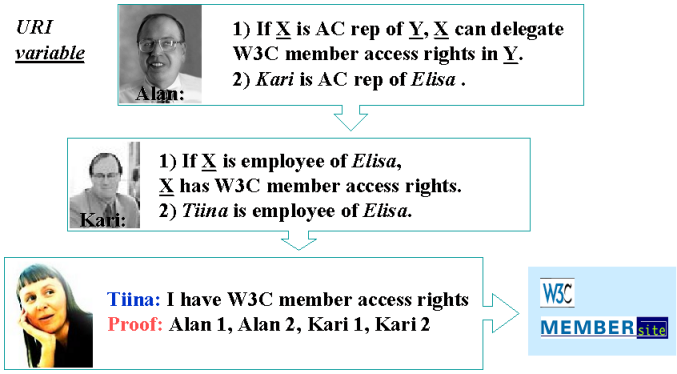W3C Semantic Web Activity
Dan Brickley
danbri@w3.org
W3C

Slides available at:
http://www.w3.org/Talks/
Semantic Web in Context
- What is it?
- The Web information model (URIs, RDF)
- What are we doing?
- The Semantic Web Activity
- Where are we going with it?
- Working Groups, Interest Groups
- Short term deployment
- Longer term research issues
- Collaboration
SW and RDF: Where did it come from?
- W3C Metadata Activity 1997-1999
- PICS (internet content selection)
- Digital Libraries, Dublin Core
- XML (XML Data, Channels etc.)
- MCF (Apple, Netscape)
- URI specification (web identifiers)
- Knowledge Representation community
RDF/SW - architectural aims
- W3C Metadata needs: PICS, DSig, DC
- Define conventions for applications that exchange 'metadata' on the Web
- RDF descriptions are written in XML
- Vocabulary semantics are defined by communities of expertise, not W3C
- Fine-grained information mixing and merging
RDF Target applications
- resource discovery, indexing, cataloguing
- privacy, preferences, user profiles
- sitemaps / web collections
- content rating, filtering, trust
- intellectual property rights
What can these diverse applications have in common?
What is RDF, really?
"Resource Description Framework"
self describing: RDF is a framework for describing resources...
- Resources: things that can be named with URIs (eg.
http:, phone:, mailto:)
- Description: statements about the properties of these resources
- Framework: a common model for diversity
The RDF specification builds upon the URI specification (for
identifiers) and XML (as an interchange format).
RDF model: one simple idea...
(the same idea that underpins the Web)
"The most fundamental specification of Web architecture, while on of the
simpler, is that of the Universal Resource Identifier, or URI. The
principle that anything, absolutely anything 'on the Web' should be
identified distinctly is core." (Tim BL)
RDF aims to build a Semantic Web of overlapping metadata
vocabularies:
- We use URIs to define and name shared metadata vocabularies
- We build 'graphs' using these vocabularies to say things...
Graphs and Webs: before RDF
How machines saw the Web before RDF - millions of linked
resources...
unknown types of resources, unknown types of relationship

Graphs and Webs: after RDF
The Web after RDF, millions of linked resources...
known types of resource, types of relationship

The common model: why use 'nodes and arcs'?
- arbitrarily extensible (just add more connections)
- we can decentralise control using URIs
- we can disagree about node and link types, yet still share infrastructure (syntax, databases, editors)
- URIs create a market for data merging, aggregation, annotation and filtering services
RDF example: document status

RDF example: data mixing...

(Semantic) Web: it's all about (hyper)linking

Information Management: A Proposal, Tim Berners-Lee, CERN, March 1989, May 1990, http://www.w3.org/History/1989/proposal.html
The Web was proposed as a tool for representing relationships amongst
named objects, drawing together knowledge from scattered systems into a
common framework. The Semantic Web initiative seeks to evolve the current Web
into a system that fulfills this original promise. Schemas and
ontologies simply define types of resource and types of inter-relationship
(wrotes, describes, refersTo...)
W3C Semantic Web Activity
- Feb 2001 Semantic Web Activity launched
- SW Activity Lead: Eric Miller <em@w3.org>
- RDF Interest Group (chair: Dan Brickley)
- RDF Core Working Group (chairs: Brian McBride, Dan Brickley)
- Web Ontology Working Group (chair: Jim Hendler)
- Advanced Development activities
- Plans
- future work likely on RDF Query and logic languages
- Better integration with Web Services and XML
- Connect research community to standards work
Semantic Web: building on proven ideas
- combine RDF, Xlink, hypertext and metadata approaches to linked data
- enable simple applications now, while planning for future complexity (eg. RSS newsfeeds)
- Focussed on general principles of Web automation and data
aggregation (XML namespaces, URI names, RDF graphs...)
Semantic Web futures: walk before we run
- Simple things first
- sitemaps, news channel syndication
- thesauri, classification, topic maps
- calandaring, scheduling, collaboration
- annotations, quality ratings, shared bookmarks
- dublin core for simple resource discovery
- web service description and discovery
- peer to peer (napster, gnutella etc.) & rights management
...and mixing all these together
SW futures: Web data tools
- Getting more ambitious:
- extending RSS newsfeeds using XML namespaces
- Simple reasoning (ontologies, thesauri)
- digital signatures (trust, provenance)
- scalability issues
- user interface challenges
...and mixing all these together
SW futures: Blue skies?
- Logic, inference, Web-of-trust....

SW: Logic and Trust scenario

Semantic Web: Where next?
On the standards track, the base layers of the Semantic Web should be
finalised during 2002: RDF syntax, RDF model, RDF schema, Web Ontology
language. In addition...
- Integration with Web Services and XML technology
- Interest Groups: connecting research and Web standardisation communities
- SW Advanced Development: targeting research and development, pre-consensus collaborations
- DARPA DAML initiative, MIT SWAD project (DAML+OIL, WebOnt WG)
- EU IST Semantic Web technologies: SWAD-Europe project (through INRIA)
- Education and outreach, working with QuestionHow, SWAD-Europe, Offices...
Getting involved
- Semantic Web home page: http://www.w3.org/2001/sw/
- Join Interest Group taskforces (Rules and Query, Calendar...)
- Feed use cases, real world scenarios into standards and development work
- New working groups? - implementation experience needed on RDF rules and query
For discussion
- W3C Offices and new members: Semantic Web bringing new communities
into W3C (Ontology, KR...)
- Exploring models for technical collaboration
- Contacts, experts, communication...
Questions








